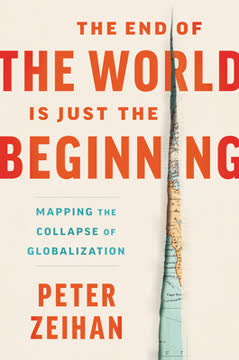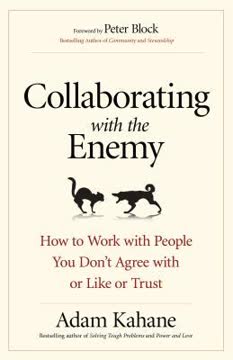Key Takeaways
1. Unilateral Action Fails: Stuck Problems Need Collaboration
More often than not, we choose to push. But often when we push, others push back, and we end up frustrated, exhausted, and stuck.
Pushing creates resistance. When faced with complex, unacceptable, or unsustainable situations, our default is often to try and force change through arguments, authority, or resources. However, in systems with many interdependent actors, this unilateral pushing inevitably meets resistance, leading to stalemate and exhaustion. This is evident in families, organizations, communities, and nations alike.
Complexity demands collaboration. Modern problems like climate change, inequality, or political polarization are too complex and unpredictable for any single person or group to solve alone. These situations require working with others across the entire system, including strangers and opponents, because no single part can grasp or shift the whole. The South African transition from apartheid, for example, required diverse actors to find a way forward together.
Direct approaches fail. In deeply polarized situations, actors often disagree not just on solutions but even on the nature of the problem itself. Attempting to implement a solution directly only entrenches positions and increases rigidity. Therefore, an indirect approach is needed, one that first builds shared understanding, relationships, and intentions before attempting direct action.
2. Transformative Scenario Planning: A Collaborative Path to Change
Transformative scenario planning offers us a new way to work together to change the future.
Beyond adaptation. Traditional scenario planning helps organizations anticipate and adapt to external changes they cannot control. Transformative scenario planning (TSP) goes further, aiming to influence and transform the problematic situation itself. It's for those who see their situation as unacceptable and cannot simply adapt or flee.
Transforming from within. TSP works by transforming the actors involved, leading to systemic change. This involves four key shifts:
- Understandings: Gaining fresh perspectives on the situation and one's role.
- Relationships: Building empathy, trust, and the capacity to work across divides.
- Intentions: Clarifying what can and must be done based on new insights.
- Actions: Taking wiser, more aligned steps individually and collectively.
A composite technology. TSP combines three essential components: a whole-system team (a microcosm of the system), a strong container (a safe yet challenging space), and a rigorous process (structured steps for exploration and action). All three are necessary for the transformation to occur.
3. Step 1: Convene a Team from Across the Whole System
The success of your project will depend above all on the people who will make up your scenario team.
Gather key actors. The first step is to bring together a diverse group of insightful, influential, and interested people from across the system you want to influence. This team should represent the different parts, perspectives, and power dynamics of the whole system, acting as a strategic microcosm. Examples include politicians, business leaders, activists, academics, and community members.
Enrollment is key. Building this team requires personal, one-on-one conversations to understand potential members' concerns, seek their advice, and invite their participation. People join if they believe their current efforts are insufficient and that collaborative work will be worthwhile and safe. Overcoming skepticism and hostility from those invested in the status quo is a major challenge.
Initial understanding. As part of convening, conduct in-depth interviews with team members and other stakeholders. Synthesize these interviews into a document that reflects the diverse perspectives on the situation. This report, shared with the team, provides a common starting point for dialogue and reveals shared concerns, even if for different reasons, helping to break down "mental durawalls."
4. Step 2: Observe What Is Happening with Fresh Eyes
Seeing the future is about seeing in the right state of focus to put your finger unerringly on the key facts or insights that unlock or open understanding.
Deepen shared understanding. The team must move beyond their established views to build a common understanding of the system's past and present. This involves open inquiry and learning from diverse perspectives within the team and from external sources. Simple exercises, like walking with someone different, can reveal surprising insights.
Structured exploration. Use various methods to examine the system:
- Learning journeys: Visit different parts of the system to experience realities firsthand (e.g., Guatemalan team visiting a rural cooperative).
- Resource people: Invite experts or "remarkable persons" with alternative views to share insights.
- Self-observation: Pay attention to the dynamics within the team as a reflection of the larger system (e.g., Israeli team observing their own divisions).
Identify driving forces. Analyze the system to identify key social, technological, economic, environmental, cultural, and political forces shaping it. Look beyond events and patterns to understand underlying systemic structures. This rigorous examination lays the foundation for constructing plausible scenarios.
5. Step 3: Construct Relevant, Challenging Scenarios
Scenarios are useful when they meet four criteria: they must be relevant, challenging, plausible, and clear.
Create multiple plausible futures. The goal is to develop a small set (2-4) of distinct stories about what could happen in the system, not what will or should happen. These scenarios must illuminate current circumstances, challenge existing assumptions, be logically consistent with observed realities, and be easy to understand and remember.
Methods for construction. Two common approaches are used:
- Deductive: Identify two key uncertainties that are impactful, unpredictable, and potentially influenceable. Use these as axes for a 2x2 matrix to generate four scenarios (e.g., Great Zimbabwe Scenarios).
- Inductive: Brainstorm many possible stories based on collective intuition and observations, then group and select the most useful ones (e.g., Sudan Scenarios).
Elaborate the stories. Flesh out each scenario with a logical narrative of hypothetical future events and consequences. Give them evocative names and images (like the birds in Mont Fleur or the objects in Guatemala) to make them memorable. Document the scenarios clearly for communication.
6. Step 4: Discover What Can and Must Be Done
What does the future need of me?
Draw meaning from scenarios. After constructing the scenarios, the team reflects on what they imply for action. This involves stepping back from the work, often through moments of pause and reflection, to discern the meaning of the possible futures for themselves, their organizations, and the system.
Embrace dual stances. The scenarios inform both adaptive and transformative responses:
- Adaptive: How to survive and thrive if each plausible scenario occurs, regardless of preference (e.g., analyzing opportunities and threats).
- Transformative: What actions are needed to influence which scenarios are more likely, based on desired outcomes and acknowledging one's role in the current situation.
Clarify intentions. Through this reflection, the team crystallizes their intentions. They identify actions they can take jointly with others on the team, actions they will take separately but in alignment, and areas where their paths diverge. This step moves from understanding possibilities to deciding on purposeful action.
7. Step 5: Act to Transform the System
Transformative scenario planning contributes to transforming systems only if the seeds it produces propagate and spread.
Engage in public action. The final step is to translate the team's transformed understandings, relationships, and intentions into action. This can range from executing joint plans to individual members acting within their own spheres of influence, aligned or not. The project's container and infrastructure should support these ongoing efforts.
Propagate the insights. The impact of TSP comes from the "seeds" of new understandings, relationships, and intentions spreading beyond the core team. This is done through:
- Direct engagement: Private briefings with key leaders, workshops with organizations, public dialogues, town hall meetings.
- Communication: Using print, broadcast, and social media to disseminate the scenarios and their implications.
- Cultural agents: Working with artists and storytellers to embed new narratives.
Cultivate the network. Maintain connections among the team and others who become involved. This ongoing network provides mutual support, learning, and coordination for continued action and spinoff initiatives. The legacy of projects like Visión Guatemala lies in the enduring cross-system relationships and the knowledge that collaboration is possible.
8. Beyond the Steps: Build a Strong Container for Dialogue
Building such a container requires paying attention to multiple dimensions of the space within which the team does their work.
Create a safe and challenging space. A critical element for transformative work is establishing a robust container. This space must provide enough safety for participants to be open and vulnerable, while also generating enough pressure and friction to challenge their existing perspectives and assumptions.
Multiple dimensions of the container:
- Political positioning: Ensure the project is seen as nonpartisan and credible, allowing diverse actors to participate without fear of reprisal or being seen as betraying their own group (e.g., Visión Guatemala's nonpartisan director).
- Psychosocial conditions: Foster an environment where participants feel able to become aware of and challenge their own thinking and relationships, and be challenged by others (e.g., the trust built among adversaries in Mont Fleur).
- Physical location: Choose meeting venues that are free from distractions and interruptions, allowing for focused work and informal connection (e.g., the spread-out farm for Destino Colombia).
Ground rules matter. Agreeing on and upholding ground rules for interaction (like speaking frankly, listening respectfully, and maintaining confidentiality) is essential for maintaining the integrity and safety of the container, especially in highly polarized contexts.
9. Beyond the Steps: New Stories Generate New Realities
As we tell and live new stories, we change what can happen in the world around us.
Scenarios as empowering myths. While scenarios are analytical tools, they can evolve into powerful narratives that shape collective perception and action. By articulating plausible futures, they can challenge dominant, stuck narratives and inspire people to work towards desired outcomes. The Dinokeng scenarios, for instance, placed citizen re-engagement at the center of South African discourse.
Influence is nonlinear. The impact of scenario work is often subtle, indirect, and unpredictable. Seeds are planted, but their germination and growth depend on many factors beyond the project's control. The Destino Colombia scenarios, initially seen as having limited impact, were later cited by the president as prophetic blueprints guiding national policy.
Shift the collective narrative. Transformative scenario planning helps actors see that repeating old stories about their situation leads to repeating old, ineffective actions. By collectively constructing and disseminating new, challenging, and plausible stories, the process helps shift the collective mindset, opening up possibilities for new behaviors and outcomes in the system.
10. The Inner Game: Suspending Assumptions and Balancing Power & Love
Succeeding in the inner game of transformative scenario planning requires dealing with a mystery wrapped in a dilemma inside a paradox.
The paradox of stepping back. Transformation in complex systems often requires an indirect approach – pausing, stepping back, and engaging in dialogue rather than pushing directly. This paradox can feel counterintuitive, especially in urgent situations, but it is necessary to break free from old patterns and enable creative emergence.
The dilemma of power and love. Effective collaborative transformation requires balancing two fundamental drives: power (the drive to realize one's potential and grow) and love (the drive to open up and connect with others). Choosing only one leads to either timid consensus (love without power) or rigid stalemate (power without love). Working with both means honoring the integrity of each individual part while also seeking connection and alignment within the larger whole.
The mystery of the future. At the heart of this work is the acceptance that the future cannot be known or controlled. Despite rigorous analysis and purposeful action, the outcome remains uncertain. Success in the inner game requires the capacity to suspend our assumptions, sit with uncertainty, and act courageously and flexibly without attachment to a specific outcome.
Last updated:
Review Summary
Transformative Scenario Planning receives generally positive reviews, with readers praising its depth, honesty, and accessibility. Many find the book inspiring and valuable for understanding societal change through scenario planning. Kahane's narrative approach and real-world examples are appreciated. Some readers note its limitations as a practical guide and desire more critical analysis. The book is particularly recommended for those interested in social transformations and scenario planning, though a few reviewers found it lacking in comprehensive instruction for organizational implementation.
Similar Books






Download PDF
Download EPUB
.epub digital book format is ideal for reading ebooks on phones, tablets, and e-readers.






